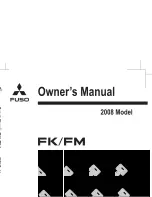
ENGINE ELECTRICAL 6Y-2
Carrier and Hold-Down
The battery carrier and hold-down should be
clean and free from corrosion before installing the
battery. The carrier should be in a sound mechan
ical condition so that it will support the battery
securely and keep it level.
To prevent the battery from shaking in its
carrier, the hold-down bolts should be tight (60-80
inch-pounds). However, the bolts should not be
tightened to the point where the battery case or
cover will be placed under a severe strain.
Cables
To insure a good electrical contact, the cables
should be clean and tight on the battery posts. If
the posts or cable terminals are corroded, the
cables should be disconnected and the terminals
and clamps cleaned separately with a soda solution
and a wire brush. After cleaning and installing
clamps, apply a thin coating of petroleum jelly on
the cable clamps to retard corrosion.
BATTERY PRECAUTIONS
1. The
electrical circuit is N E G A T I V E
G R O U N D . Installing battery with positive term
inal grounded will result in serious damage to
generator, battery, and battery cables.
2. When attaching battery charger leads or a
booster battery, connect positive lead to battery
positive post, then connect negative lead to battery
negative post.
3. D O N O T smoke near a battery which is
being charged.
C O M M O N CAUSES O F B A T T E R Y F A ILU R E
When a battery fails, the cause of failure may
lie outside the battery itself. For this reason, when
a battery failure is encountered, do not be satis
fied to merely recharge or replace it. Find the
cause of the failure and prevent recurrence of the
trouble. Listed below are some of the common
causes of battery failure:
1. Defect in generating system such as high
resistance, slipping generator drive belt, faulty
generator or regulator.
2. Overloads caused by defective starter or
excessive use of accessories.
3. Dirt and electrolyte on top of battery caus
ing a constant drain.
4. Hardened battery plates, commonly called
"sulfation,” due to battery being in a low state of
charge over a long period of time.
5. Physical defects such as shorted cells, loss
of active material from plates, etc.
6. Driving conditions or requirements under
which the vehicle is used only for short drives.
O N E PIECE
CELL C O V E R
ELECTROLYTE LEVEL
IN D IC A T O R
Figure J— Typical Battery with One Piece Cover
BATTERY CHARGING
There are three methods of recharging bat
teries. They differ basically in the length of time
the battery is charged and the rate at which charg
ing current is supplied. One is the Slow Charge
method, the second is the Fast Charge method, and
the third is the Emergency Boost Charge method.
Before recharging a battery by any method, the
electrolyte level must be checked and adjusted.
S L O W C H A R G IN G
The Slow Charge method supplies the battery
with a relatively low current flow for a relatively
long period of time. This is the only method that
will bring the battery to a full state of charge.
The Slow Charge method consists of charging
at a rate in amperes equal to 7% of the battery's
ampere-hour capacity. (Refer to "Specifications"
at end of this section for ampere-hour rating of
batteries used.) This is the "Normal" charge rate.
The battery is fully charged when specific gravity
readings taken at hourly intervals show no increase
during three consecutive readings.
A very low rate — not more than one-half the
normal charging rate — should be used for charg
ing a sulfated battery. In the case of badly sulfated
batteries, as much as 100 hours of charging time
may be required before the battery becomes fully
charged. Badly sulfated batteries may require a
continuous slow charge for 48 hours or more be
fore a rise in gravity reading occurs. If the spec
ific gravity reading of any cell fails to reach 1.250
CHEVROLET SERIES 70-80 H EAVY DUTY TRUCK SH O P M A N U A L
Summary of Contents for 70 1969 Series
Page 1: ...CHEVROLET HEAVY DUTY TRUCK SHOP MANUAL...
Page 3: ......
Page 11: ...LUBRICATION 0 4 CHEVROLET SERIES 70 80 HEAVY DUTY TRUCK SHOP MANUAL...
Page 27: ......
Page 119: ......
Page 361: ......
Page 371: ......
Page 427: ......
Page 443: ......
Page 451: ......
Page 493: ......
Page 499: ......
Page 549: ......
Page 555: ......
Page 609: ......
Page 715: ...am...
Page 745: ......
Page 910: ......
Page 913: ......








































